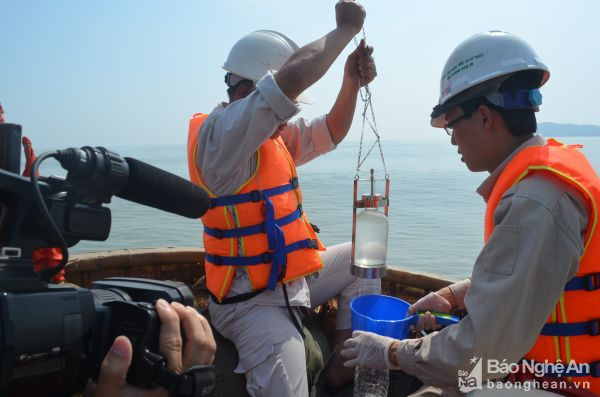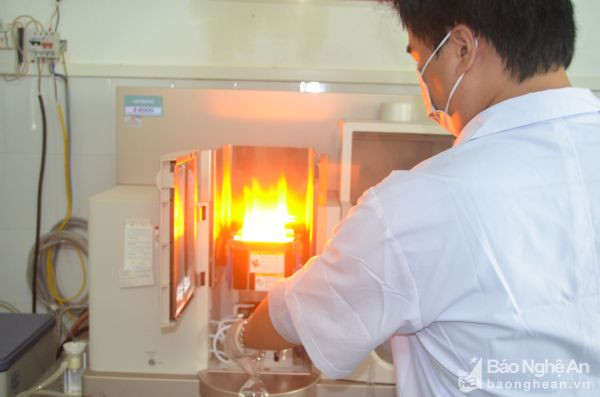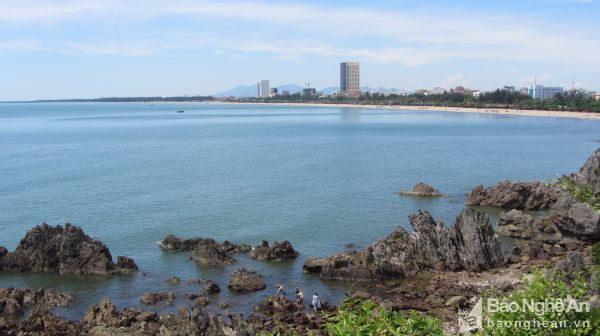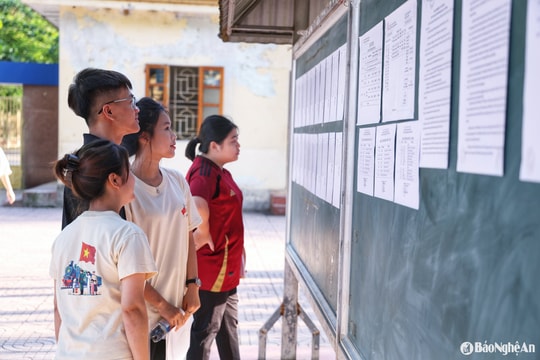Timely and accurate information about the marine environment
(Baonghean) - Since the Formosa incident in 2016, the frequency of marine environmental monitoring has been increased to update information promptly and accurately.
Increase monitoring frequency
Since the end of April 2016, the marine pollution incident caused by Formosa has seriously affected the marine environment quality of the central coastal provinces. Adjacent to Ha Tinh province, only about 100km from Vung Ang beach, the epicenter of the pollution incident, the quality of Nghe An's seawater has always been a matter of public concern.
 |
| According to the staff of the Center for Natural Resources and Environment Monitoring, seawater sampling points for monitoring must be taken at the beach, not more than 1.5km from the shore and at a depth of 0.3 - 0.5m. Photo: Ha Giang |
Normally, marine environmental monitoring is carried out 4 times/year (spread evenly in March, June, September and December). However, before the Formosa incident, with the approval of the Provincial People's Committee, the Department of Natural Resources and Environment directed the Center for Natural Resources and Environment Monitoring to step up the implementation of the marine environmental monitoring program from the end of April 2016. Accordingly, the monitoring frequency was increased and the sampling points were also denser, stretching along the entire coastline of Nghe An from Cua Lo Town to Hoang Mai Town.
According to statistics from the Department of Natural Resources and Environment, the "hottest" period was from April 27 to June 5, 2016. At this time, coastal seawater samples were taken at the following beaches: Quynh Phuong (Hoang Mai Town), Quynh Nghia (Quynh Luu), Dien Thanh (Dien Chau), Cua Lo, Cua Hoi (Cua Lo Town). On peak days, the monitoring centers of the Ministry of Natural Resources and Environment and the province conducted monitoring twice a day; a total of 19 monitoring times were conducted with 41 seawater samples.
Of which, Nghe An Center for Natural Resources and Environment Monitoring independently conducted 10 monitoring sessions with 23 seawater samples; Environmental Monitoring Center (General Department of Environment, Ministry of Natural Resources and Environment) coordinated with Nghe An Center for Natural Resources and Environment Monitoring to conduct 9 monitoring sessions with 18 seawater samples (from May 2 to May 6, 2016).
Director of the Center for Natural Resources and Environment Monitoring, Mr. Le Van Hung said that although the seawater parameters in the province were guaranteed through monitoring, the Provincial People's Committee requested the Department of Natural Resources and Environment and its affiliated units to focus on marine environmental monitoring; including the occasion of November 2016, when the Ministry of Natural Resources and Environment assessed and announced that the marine environment in the Central provinces had been ensured to be safe.
 |
| Engineer Le Duy Khanh operates the ASS atomic absorption spectrometer to analyze the content of heavy metals dissolved in water. Photo: Ha Giang |
At present, the Provincial People's Committee has assigned the task of ensuring the frequency of implementation once a week. The direction of the Provincial People's Committee is shown in Official Dispatch No. 1553/UBND-NN dated March 15 on the implementation of the seawater quality monitoring program during the tourist season; with the content: "Agree to organize marine environmental monitoring at Dien Thanh, Quynh Phuong, Cua Lo, Cua Hoi beaches, with a frequency of once a week from April 1 to August 30.
In addition to reporting the results of each monitoring session to the Provincial People's Committee, relevant agencies and units, local authorities (ward, commune, town level), the Department of Natural Resources and Environment must also coordinate with the Radio and Television Station, Nghe An Newspaper to publish the information on news bulletins and printed newspapers, so that people can be informed...
Ensure information accuracy
To accurately assess the marine environment, 13 parameters in seawater will be monitored, including temperature, pH, dissolved oxygen, turbidity, salinity, suspended solids, ammonium, phosphate, cyanide, arsenic, manganese, iron, and coliforms. Of these, 5 parameters are measured and analyzed in the field (temperature, salinity, turbidity, pH, dissolved oxygen content (DO); 8 parameters are analyzed in the laboratory (suspended solids (TSS), ammonium (NH4+), phosphate (PO43-), cyanide (CN-), arsenic (As), manganese (Mn), iron (Fe), coliforms).
At the Center for Natural Resources and Environment Monitoring, the capacity to implement environmental monitoring programs in general and marine environmental monitoring programs in particular has been ensured. In particular, the Environmental Monitoring Department and the Center's Laboratory have both been recognized as meeting the Quality Management System standards according to ISO/IEC17025:2005 with the code numbers Vilas 951 and 551.
The analysis parameters are performed in accordance with international standard methods or TCVN/other recognized internal construction methods. In addition, the center has also been granted a Certificate of eligibility for environmental monitoring services in Decision No. 1237/QD-BTNMT dated June 25, 2014 of the Minister of Natural Resources and Environment with code number VIMCERTS 005.
Regarding the equipment of the center, it is fully invested, meets the requirements of the work and is managed and inspected according to regulations. The monitoring parameters are monitored and analyzed on a system of modern and accurate equipment; in particular, the parameters of heavy metals are analyzed on an atomic absorption spectrometer AAS.
 |
| Cua Lo Beach seen from Lan Chau Island. Photo: Ha Giang |
Mr. Le Van Hung added: Implementing the direction of the Provincial People's Committee, the Department of Natural Resources and Environment, the Center for Natural Resources and Environment Monitoring has proactively and promptly deployed and planned the marine environmental monitoring program in accordance with the instructions in Circular No. 31/2011/TT-BTNMT dated August 1, 2011 on Technical procedures for marine environmental monitoring from designing the monitoring program, organizing the implementation of monitoring, environmental analysis and handing over the results. The program is also designed with regulations on quality assurance and quality control in environmental monitoring (QA/QC) according to Circular No. 21/2012/TT-BTNMT dated December 19, 2012 of the Ministry of Natural Resources and Environment.
“On April 4, 10, and 17, 2017, the Center conducted three sampling sessions at four locations in Quynh Phuong, Dien Thanh, Cua Lo, and Cua Hoi seas. On-site and laboratory analysis showed that the seawater quality of all three sessions met the prescribed standards. The Center promptly reported the results to the Provincial People's Committee, Department of Natural Resources and Environment, districts, towns, media agencies, etc. as directed by the province in Official Dispatch No. 1553,” said Mr. Le Van Hung.
Ha Giang
| RELATED NEWS |
|---|





.png)
.jpg)

